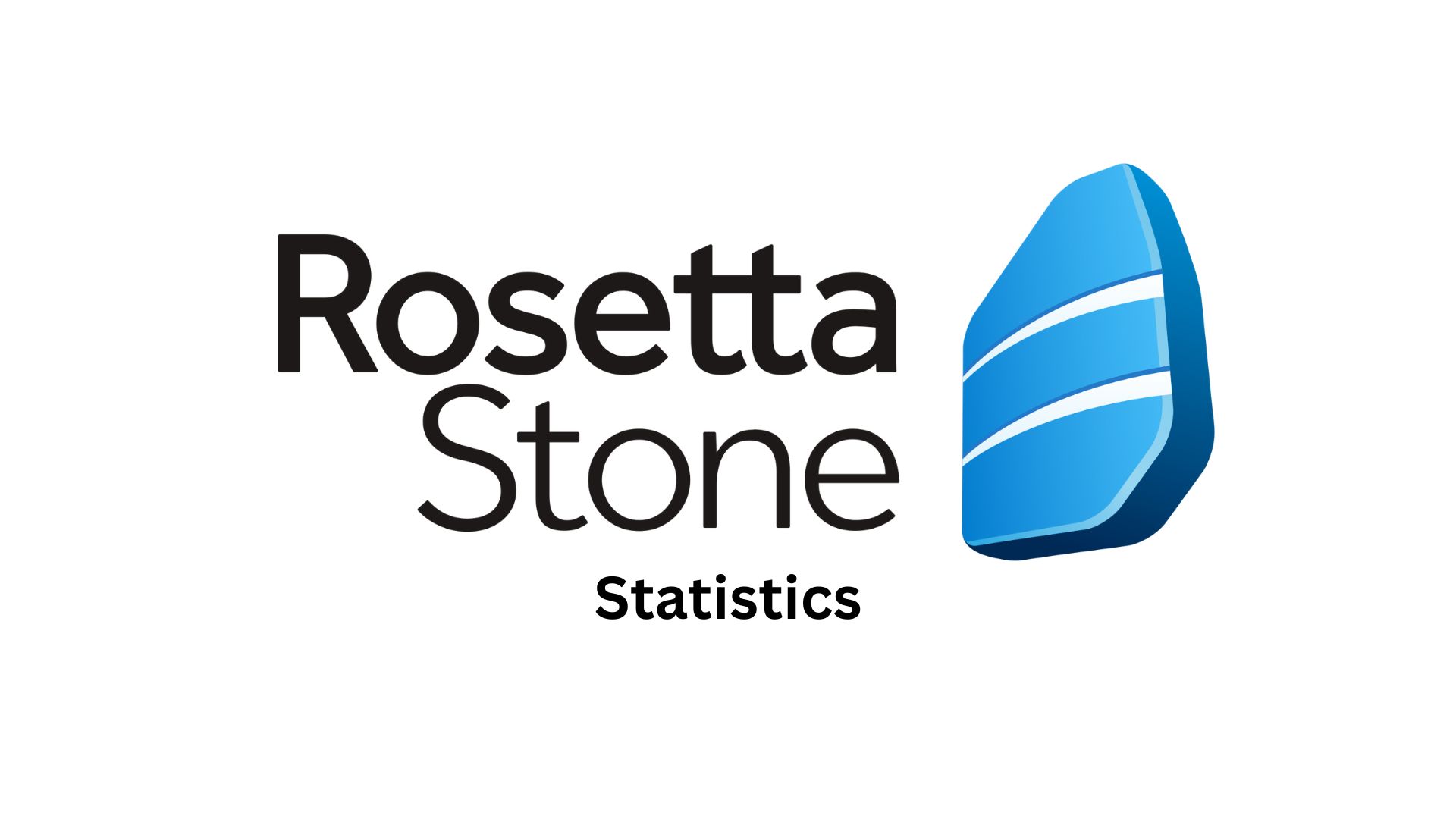Sports Tourism Statistics By Revenue, Travelers and Spending
Updated · Mar 24, 2025

Table of Contents
- Introduction
- Editor’s Choice
- By Market Size
- Viewership In The Olympic Ceremony
- Viewership Intent Of FIFA World Cup
- Tourism Impact of Paris 2024 Olympics vs. 2019
- FIFA Revenue
- Sports Tourism in India
- State of the Industry Report on Sports Tourism (2021)
- Sports Traveler Volume
- Sports Traveler Spending
- Recent Happenings
- Conclusion
Introduction
Sports Tourism Statistics: Sports tourism is a special type of tourism where a visitor either watches sporting events as a spectator or takes part in them. In today’s globalized world, economies have recognized the importance of sports tourism and have made substantial investments.
By examining sports tourism statistics, we can explore its significance and understand why it has become a crucial part of any nation’s economy.”
Editor’s Choice
- Economic Impact: The sports tourism industry generated an economic impact of $91.8 billion in 2021, with direct spending contributing $39.7 billion. This sector supported 635,000 jobs and produced $12.9 billion in tax revenue.
- Industry Trends: In 2021, the sports tourism sector experienced a strong recovery from the COVID-19 pandemic, with sports traveler numbers increasing by 82% year-over-year, reaching 175 million. This was only 2.6% below the peak levels seen in 2019.
- Spending Breakdown: Sports travelers, event organizers, and venues contributed $9.7 billion on transportation, $8.4 billion on lodging, and $7.5 billion on food and beverages. Lodging was significant, accounting for 21% of all sports-related travel spending and generating 66.5 million room nights.
- Global Market Growth: The global sports tourism market is projected to reach approximately $2,327 billion by 2032, up from $511.9 billion in 2022, with a CAGR of 16.8% from 2023 to 2032. This growth is driven by international sporting events like the Paris Olympics and Formula 1.
- Regional Insights: Europe is the largest sports tourism market, contributing 38.01% of global revenue. Spain, for example, attracted 4.8 million sports tourists in 2021, with 57% of revenue generated by active tourists participating in sports.
- India’s Market Dynamics: In India, sports tourism is on the rise, with 71% of Indians expressing a desire to travel to watch their favorite teams and players. The country is among the top five nations booking for the Paris Olympics 2024.
- Domestic Tourism: More than 30% of tourists in 2023 engaged in some form of sporting activity during their trips.
- Revenue Highlights: FIFA’s revenue peaked at USD 5,769.21 million in 2022. The 2012 London Olympics opening ceremony had the highest U.S. viewership, with 40.7 million viewers.
By Market Size
- Market Size and Growth: The global sports tourism market is projected to reach USD 2,327 billion by 2032, growing from USD 511.90 billion in 2022, with a CAGR of 16.80% from 2023 to 2032.
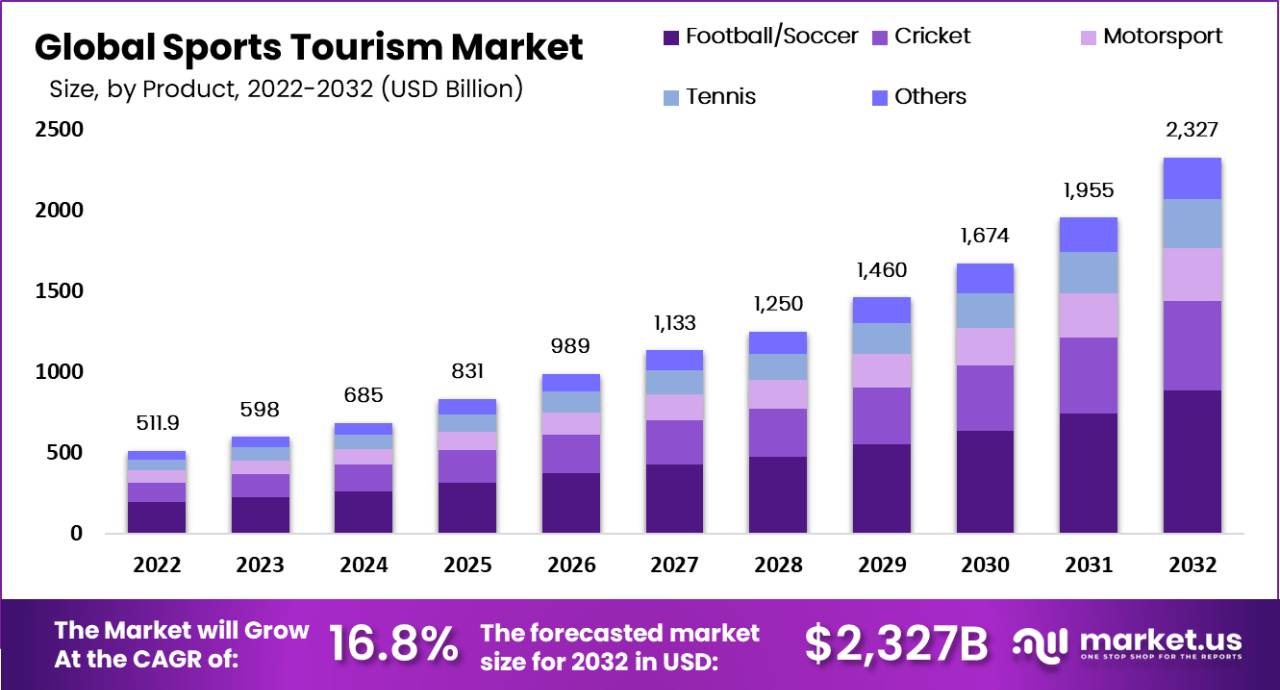
- Football/Soccer: Football, the world’s most popular sport, dominates the sports tourism market with a 38% revenue share. Major tournaments like the FIFA World Cup and UEFA Champions League attract millions of fans globally, contributing substantially to host nations’ economies.
- Cricket: Cricket is a key driver in countries like India, Australia, and England. Events like the ICC Cricket World Cup and IPL draw large crowds and generate significant tourism income.
- International Tourism: International sports tourism holds a 61% market share, driven by global events like the Olympic Games and FIFA World Cup. This segment involves travel to participate in or watch sports abroad.
- Europe: Europe leads the market with a 37% share, thanks to its rich sports heritage and popular events across football, rugby, and tennis. The region’s investment in sports infrastructure further strengthens its position.
Viewership In The Olympic Ceremony
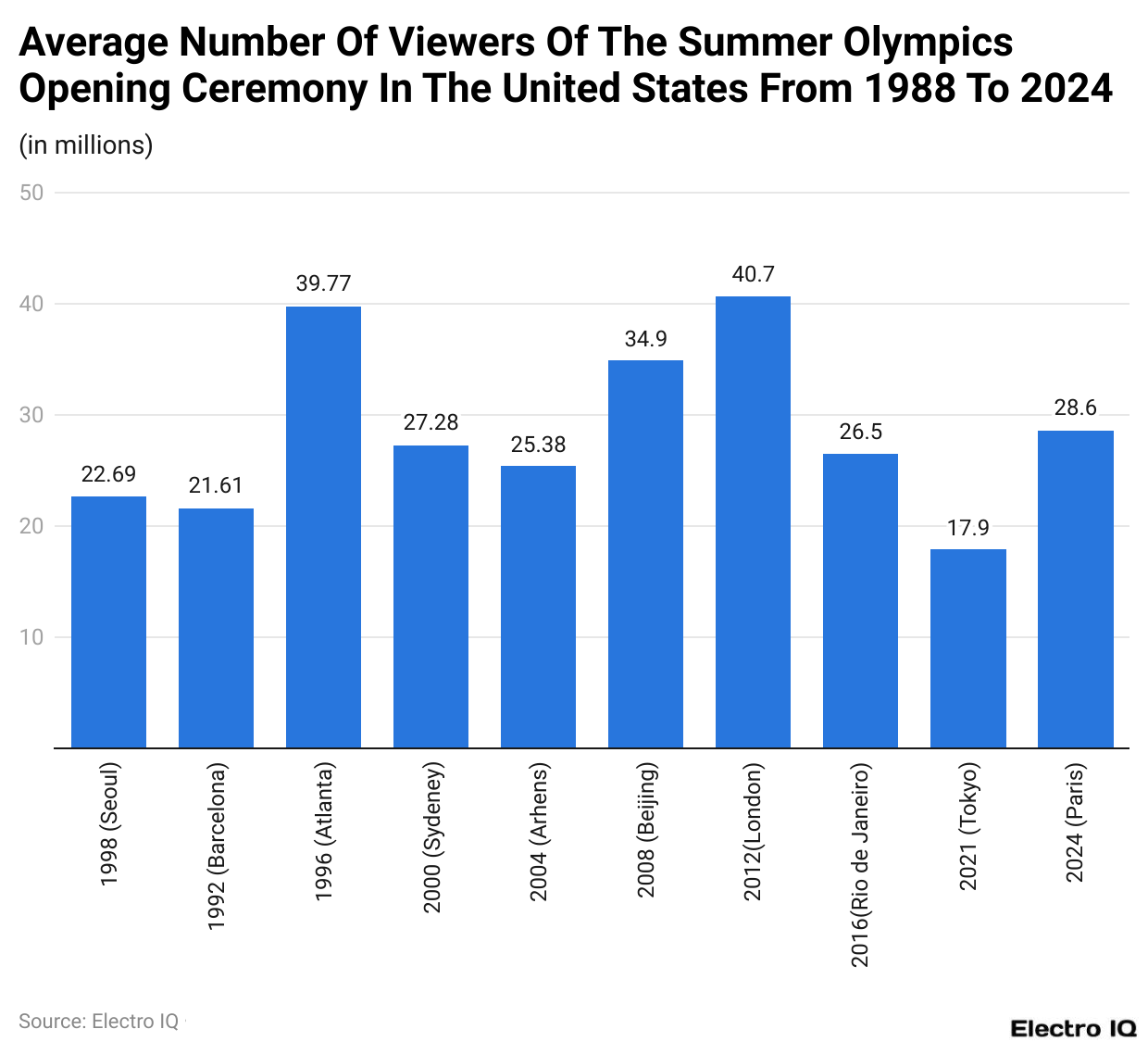
(Reference: Statista.com)
- With almost 40.7 million people, the Summer Olympics opening ceremony in the United States had the highest viewership of the 2012 London Games.
- A sizable audience also watched the Atlanta Games in 1996, totaling about 39.77 million spectators.
- With 17.9 million viewers, the 2021 Tokyo Games had the lowest audience. This was probably due to the COVID-19 epidemic and the lack of in-person spectators.
- With 28.6 million viewers, the 2024 Paris Games saw a significant rise in viewership over the 2021 Tokyo Games.
- Based on sports tourism statistics, it can be inferred that viewing has fluctuated considerably, with peaks frequently occurring during Olympic fever or games staged in nations with close historical and cultural links to the United States.
Viewership Intent Of FIFA World Cup
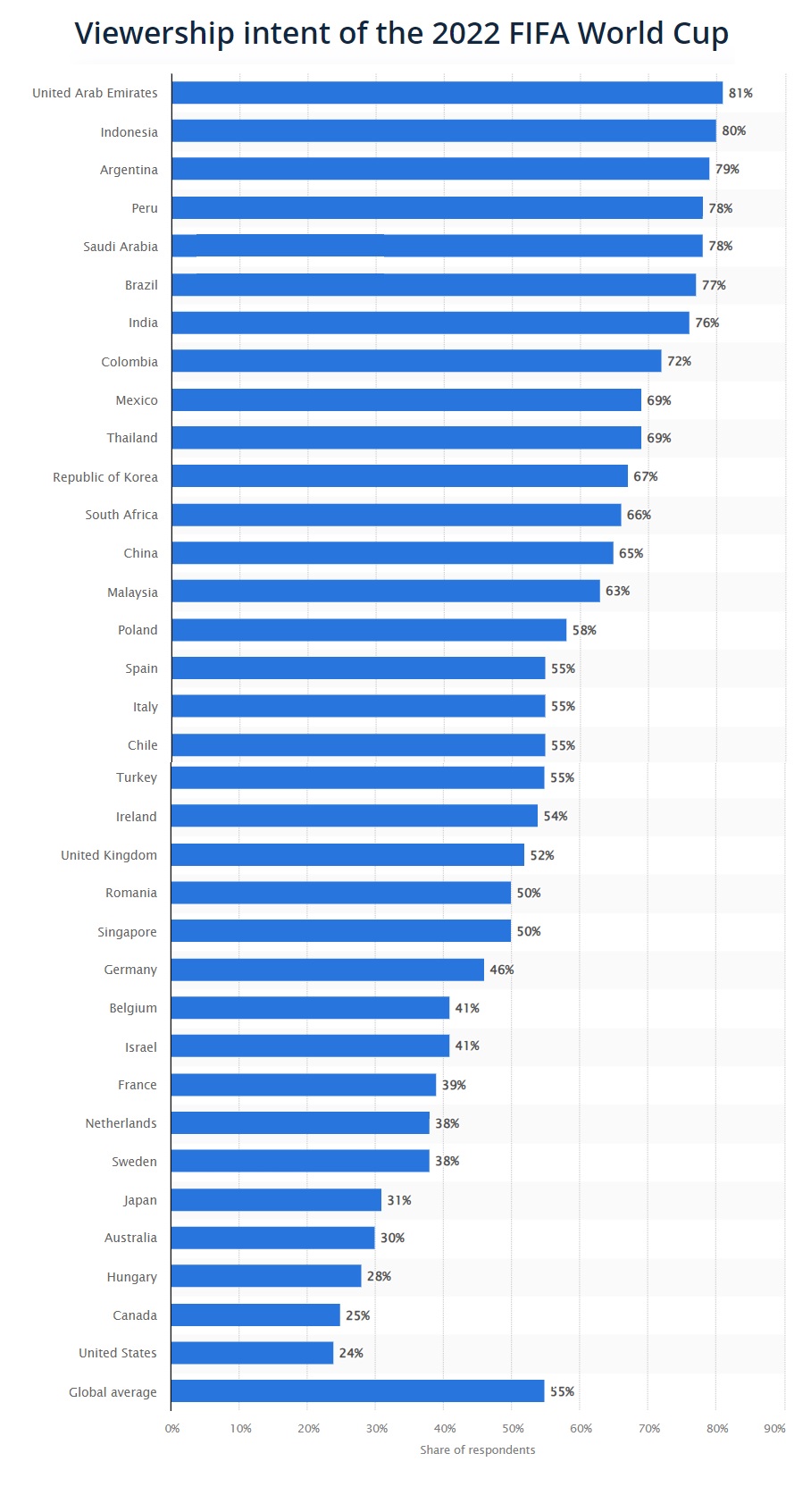
(Reference: Statista.com)
- FIFA World is another sporting event that rivals the Olympics in terms of global viewership
- According to sports tourism statistics, 81% of UAE residents intended to watch the 2022 FIFA World Cup, followed by Indonesia and Argentina.
- These figures show that FIFA is prevalent even in countries that do not participate in the FIFA World Cup.
- This neutral viewership also plays a vital role in a sports competition’s popularity.
Tourism Impact of Paris 2024 Olympics vs. 2019
Expected impact of the Paris 2024 Olympic Games on tourism in France and Paris compared to 2019
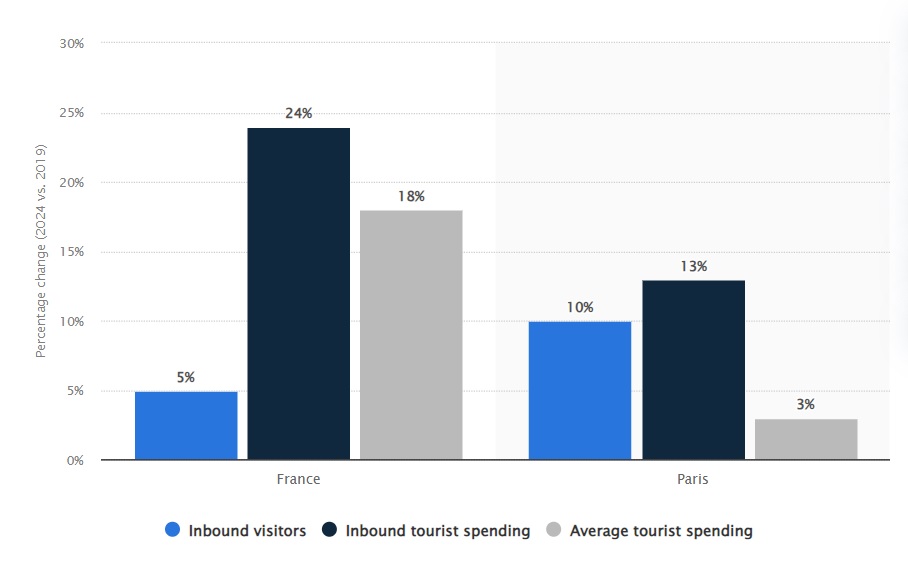
(Source: Statista)
- A study conducted in March 2024 assessed the projected impact of the 2024 Olympic Games on tourism in France and Paris.
- The analysis indicates that inbound visitors to France are expected to increase by 5% in 2024 compared to 2019.
- In Paris, the number of inbound visitors is anticipated to rise by 10% during the same period.
- Inbound tourist spending in France is forecast to grow by 24% in 2024 compared to 2019.
- In Paris, tourist spending is projected to increase by 13% over the same period.
FIFA Revenue
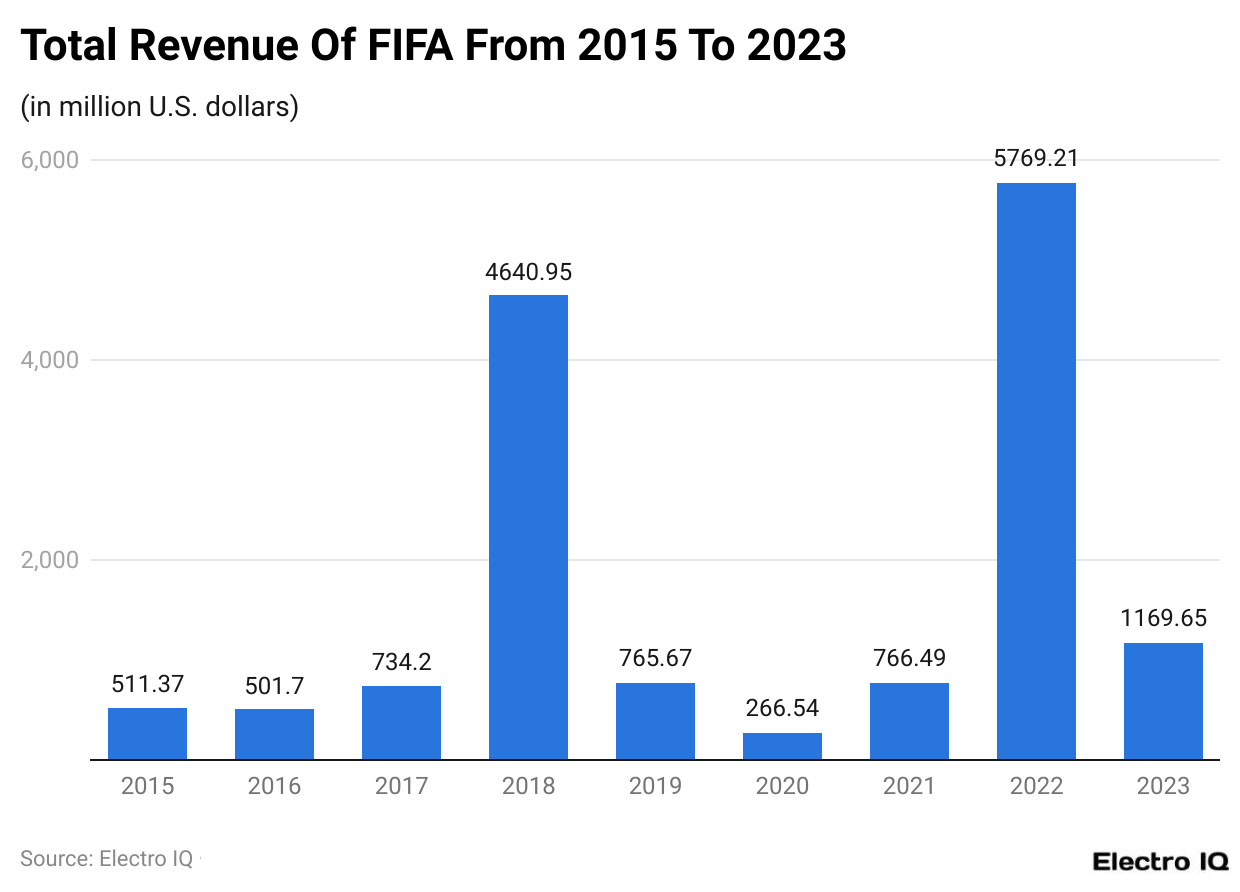
(Reference: Statista.com)
- Referring to Sports tourism statistics, one can infer a direct correlation between World Cup-based sports spectacles leading to higher revenue.
- High Revenue in 2018 and 2022: With $4,640.95 million in 2018 and $5,769.21 million in 2022, 2018 and 2022 experienced much more significant revenues than previous years. The FIFA World Cup occurs every four years and coincides with this revenue boom. FIFA’s most profitable event is the World Cup, which brings in money from ticket sales, merchandise, sponsorships, and television rights.
- World Cup Impact: The FIFA World Cup has a significant financial impact, as evidenced by the revenue spikes in 2018 and 2022. The event significantly increased FIFA’s overall earnings these years because of the increased global attention and related marketing opportunities.
- Consistent Revenue in Non-World Cup Years: Between $266.54 million (2020, perhaps due to the COVID-19 pandemic) and $766.49 million (2021), revenue is comparatively consistent in non-World Cup years (2015, 2016, 2017, 2019, 2020, 2021, 2023). The primary sources of these profits include commercial partnerships, licensing, and other football-related events.
- Revenue Drop Following World Cup 2022–2023: Following the 2022 World Cup, 2023’s revenue fell to $1,169.65 million. This drop shows the considerable lift the World Cup offers, which is not sustained in the following year, even though it is still greater than non-World Cup years.
Sports Tourism in India
- The travel industry is experiencing a shift in traveler preferences, with sports tourism emerging as a significant trend. This segment is gaining recognition and is projected to reach around USD 1.8 billion globally by 2030.
- A major example of this growth in India was observed during the 2023 World Cup, where international fans traveled to India to support their teams.
- Data from Booking.com indicates that 45% of global travelers are interested in attending various sporting events, such as the Paris Olympics, Formula 1, and the World Cup. India ranks among the top 5 countries for bookings related to the Paris Olympics 2024.
- Within India, 76% of travelers expressed interest in domestic sports tourism, with 70% specifically wanting to attend live matches of popular leagues like the Indian Premier League (IPL), Pro Kabaddi, and the Indian Super League (ISL).
- Among Indian tourists, 71% wish to travel to support their favorite teams and players, while 56% plan trips specifically to attend sports matches.
- Additionally, 67% of travelers view sporting events as opportunities to reconnect with distant friends and family, highlighting the social value of sports tourism.
State of the Industry Report on Sports Tourism (2021)
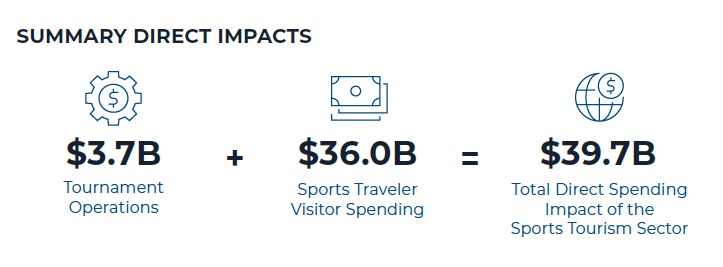
- Economic Impact: The sports tourism sector generated a total economic impact of $91.8 billion in 2021, which included direct spending, indirect expenditures, and induced expenditures.
- Direct Spending: Total direct spending in the sector amounted to $39.7 billion, which included $3.7 billion from tournament operations and $36.0 billion from sports traveler spending.
- Employment: The sports tourism sector supported 635,000 jobs in 2021, encompassing both full-time and part-time positions across various industries.
- Tax Revenues: The sector generated $12.9 billion in total tax revenues, with $6.2 billion going to state and local governments.
- Sports Traveler Volume: In 2021, the number of sports travelers in the U.S. rebounded to 175 million, reflecting an 82.0% increase from 2020, although it was still slightly below the 2019 peak.
- Spending Breakdown:
- Transportation: $9.7 billion
- Lodging: $8.4 billion
- Food & Beverage: $7.5 billion
- Recreation: $5.3 billion
- Retail: $5.0 billion
- Room Nights: Sports-related travel generated 66.5 million room nights in 2021, reflecting the importance of lodging to the sector’s overall economic impact.
Sports Traveler Volume
- The sports traveler market in the U.S. reached a peak in 2019 before being significantly impacted by the COVID-19 pandemic.
- In 2020, the pandemic led to the cancellation or postponement of numerous sports events, resulting in a 46.5% year-over-year decline in sports traveler volume, with only 96 million travelers.
- In 2021, the market showed strong recovery, increasing by 82.0% compared to 2020, reaching 175 million sports travelers.
- The 2021 volume was only 2.6% lower than the 2019 peak, indicating a robust rebound in the sector.
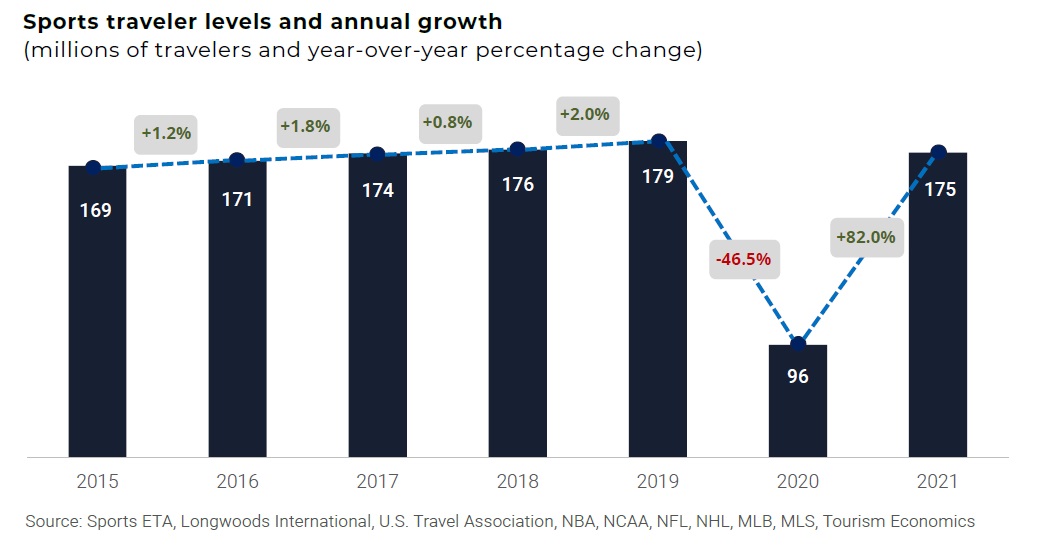
Sports Traveler Spending
- In 2021, spending by sports travelers, event organizers, and venues reached $39.7 billion.
- The significant impact of the pandemic in 2020 caused a sharp decline in sports traveler spending, which fell by 53.5% year-over-year to $21.0 billion.
- The reduction in spending was driven by fewer expenditures on food, beverages, retail, and entertainment, as well as a shift towards participating in tournaments closer to home, which lowered transportation costs.
- In 2021, sports traveler spending rebounded with an 89.2% year-over-year increase, totaling $39.7 billion. However, this figure remained below pre-pandemic levels.
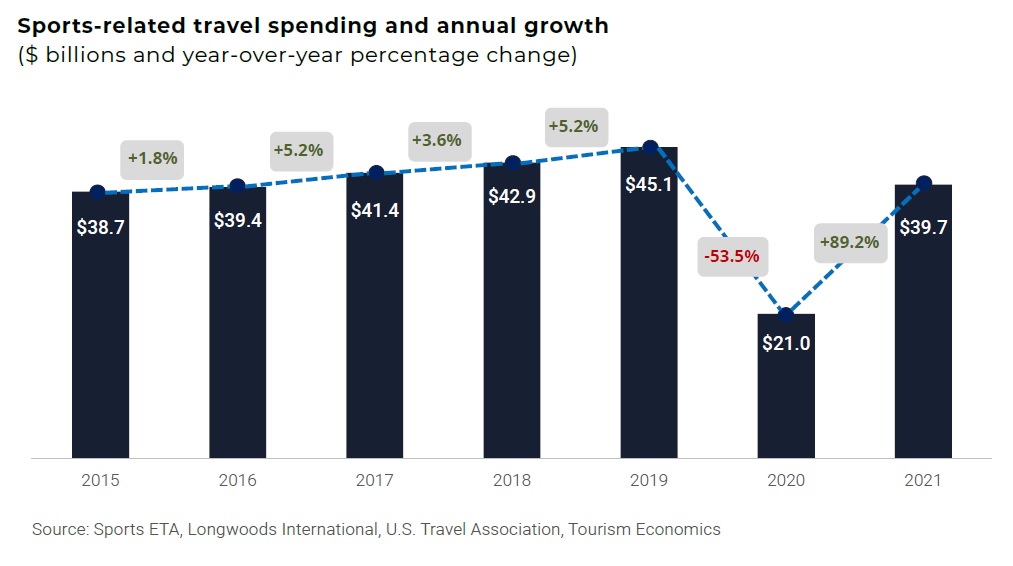
Recent Happenings
- Paris 2024 Olympics: The 2024 Summer Olympics in Paris are expected to significantly boost sports tourism, attracting between 2.3 to 3.1 million unique visitors. The event is projected to generate around EUR 10.7 billion in economic impact, with EUR 2.6 billion directly attributed to tourism spending. This influx is anticipated to increase international arrivals in Paris by 14% above 2019 levels, reinforcing France’s position as Europe’s leading tourist destination.
- Rugby World Cup 2023: The 2023 Rugby World Cup, also held in France, brought in about 600,000 international visitors. This event served as a precursor to the Olympics, showcasing France’s capability to host large-scale sporting events and contributing significantly to the local economy through tourism spending.
Conclusion
In conclusion, sports tourism will continue to be a significant driver of economic growth in the global tourism industry in 2024. The market is expected to reach a value of over $600 billion US dollars, with solid growth in established and emerging markets. Significant events like the Summer Olympics and the UEFA Euro Championship will drive this growth, attracting millions of tourists and generating billions in economic impact.
However, the industry will face several challenges, including geopolitical tensions and economic uncertainties. To mitigate these risks, stakeholders in the sports tourism industry will need to adopt innovative strategies and focus on sustainability to ensure long-term growth and success. As the market evolves, the role of technology and sustainability will become increasingly important, shaping the future of sports tourism in the years to come.
Sports Tourism Statistics will continue to be a valuable tool for understanding the trends and dynamics of this rapidly growing market, providing insights that can help businesses and policymakers make informed decisions. As we look ahead to 2024, the sports tourism industry is poised for continued growth, offering exciting opportunities for travelers, event organizers, and destinations worldwide.
Sources
FAQ.
More than 60% of worldwide income comes from Europe and North America.
As per sports tourism statistics, it is more than $600 billion.
When picking locations and activities, more than 70% of sports visitors will give sustainability a top priority.

Barry Elad is a tech enthusiast who loves diving deep into various technology topics. He gathers important statistics and facts to help others understand the tech world better. With a keen interest in software, Barry writes about its benefits and how it can improve our daily lives. In his spare time, he enjoys experimenting with healthy recipes, practicing yoga, meditating, or taking nature walks with his child. Barry’s goal is to make complex tech information easy and accessible for everyone.





